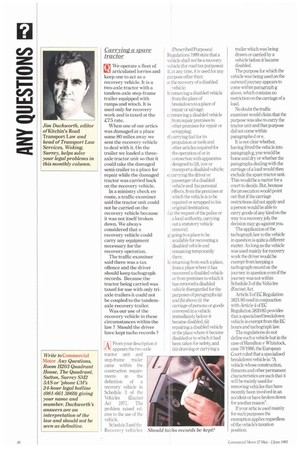A From your description it appears the two-axle tractor unit
Page 42

If you've noticed an error in this article please click here to report it so we can fix it.
and step-frame trailer came within the construction require ments in the definition of a recovery vehicle in Schedule 3 of the Vehicles (Excise) Act 1971. The problem raised relates to the use of the vehicle.
Schedule 3 and the Recovery vehicles (Prescribed Purposes) Regulations 1989 state that a vehicle shall not be a recovery vehicle (for mad tax purposes) if, at any time, it is used for any purpose other than: a: the recovery of a disabled vehicle; b: removing a disabled vehicle from the place of breakdown to a place of repair or salvage; c: removing a disabled vehicle from repair premises to other premises for repair or scrapping d: carrying fuel for its propulsion or tools and other articles required for the operation of or in connection with apparatus designed to lift, tow or transport a disabled vehicle; e: carrying the driver or passenger of a disabled vehicle and his personal effects, from the premises at which the vehicle is to be repaired or scrapped to his original destination; fat the request of the police or a local authority wrrying out a statutory vehicle removal; g: going to a place to be available for recovering a disabled vehicle and remaining temporarily there; It: returning from such a place, from a place where it has recovered a disabled vehicle or from premises to which it has removed a disabled vehicle disregarded for the purposes of paragraphs (a) and (b) above; (i) the carriage of persons or goods conveyed in a vehicle immediately before it became disabled, (ii) repairing a disabled vehicle at the place where it became disabled or to which it had been taken for safety and (iii) drawing or carrying a trailer which was being drawn or carried by a vehicle before it became disabled.
The purpose for which the vehicle was being used on the outward journey appears to come within paragraph g above, which contains no restriction on the carriage of a load.
No doubt the traffic examiner would claim that the purpose was also to can-y the tractor unit and that purpose did not come within paragraphs d ore.
It is not clear whether, having fitted the vehicle into paragraph g, you would be home and dry or whether the paragraphs dealing with the carriage of a load would then exclude the spare tractor unit. This would be a matter for a court to decide. But, because the prosecution would point out that if the carriage restrictions did not apply and a person would be able to carry goods of any kind on the way to a recovery job, the decision may go against you.
The application of the tachograph law to the vehicle in question is quite a different matter. As long as the vehicle was used mainly for recovery work the driver would be exempt from keeping a tachograph record on the journey in question even if the journey was not within Schedule 3 of the Vehicles (Excise) Act.
Article 3 of EC Regulation 3821/85 read in conjunction with Article 4 of EC Regulation 3820/85 provides that a specialised breakdown vehicle is exempt from the EC hours and tachograph law.
The regulations do not define such a vehicle but in the case of Hamilton v Whitelock, case 79/1986, the European Court ruled that a specialised breakdown vehicle is: "A vehicle whose construction, fitments and other permanent characteristics are such that it will be mainly used for removing vehicles that have recently been involved in an accident or have broken down for another reason".
If your artic is used mainly for such purposes the exemption applies regardless of the vehicle's taxation position.




















































































